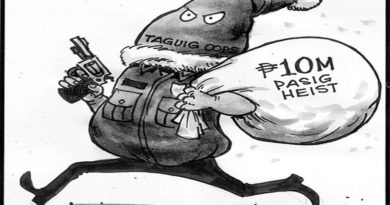SCI-TECH-ENTOMOLOGY: Bees use natural GPS to return home at night

THE WASHINGTON POST – Go to a park on a hot summer day, and you will not be surprised to see bees buzzing in and out of flowers. They drink flower nectar and collect flower pollen. Then, depending on what kind of bees they are – we know of 20,000 species around the world – they fly back to their hives or nests.
In the tropical forest of Barro Colorado Island in Panama, you will encounter native sweat bees (Megalopta genalis) only during the night. They collect nectar and pollen just after sunset and about an hour before sunrise. It is so dark at these times that “if you extend a hand out as far as you can, you wouldn’t be able to see your thumb,” said William Wcislo.
He’s a senior scientist at the Smithsonian Tropical Research Institute at Barro Colorado.
How are these green-and-gold bees able to find their way around in such dim light? That was the question Wcislo and collaborators from Sweden wanted to ask.
The trick to studying animal behaviour, said Wcislo, is “knowing what thing (the animals are) trying to do so you can ask questions in a way that they’re able to tell the answer”.
For bees and wasps, we know that after they get food, “they’re trying to get home, and they have the ability to navigate through really complex environments,” Wcislo said.
One of the ways they do this is the same as humans. We memorise landmarks such as a train station or a Starbucks shop that show us how to get back to our house. The sweat bees do this, too. When the bees leave the twig nests that they build hanging from branches, “they turn around and face the nest and fly around it. They’re learning, where’s the ‘Starbucks’,” said Wcislo.
How do they see the nest in the dark? The researchers thought maybe they look up at the forest canopy, where blobby patterns of the night sky look slightly brighter against the super-dark tree leaves. Do the bees recognise these patterns to get home?
The researchers built nests that had different patterns of black-and-white stripes over their entrances. The bees could find the nest that matched the pattern they memorised when they left home, even if the researchers moved its location.
This ability to navigate using forest canopy patterns, said Wcislo, “is fairly remarkable. It shows that this is a sensory world and what these bees pay attention to is richer than we thought before.”
It also shows that light pollution (too much artificial light) could confuse bees and other animals that are active at night: They need the pitch dark to navigate their own special way. Wcislo said the good news is that we can prevent light pollution. For example, people can programme highway lights to turn off when there are no cars on the road, and we can use different wavelengths of light that do not disturb animals.
“If we want plants and fruits, we need pollinators” such as sweat bees, Wcislo said. And by figuring out what they need to navigate, we can do better work to help conserve them.












